AMD’s 5 GHz Turbo CPU in Retail: The FX-9590 and ASRock 990FX Extreme9 Review
by Ian Cutress on August 9, 2014 8:00 AM ESTGaming Benchmarks
F1 2013
First up is F1 2013 by Codemasters. I am a big Formula 1 fan in my spare time, and nothing makes me happier than carving up the field in a Caterham, waving to the Red Bulls as I drive by (because I play on easy and take shortcuts). F1 2013 uses the EGO Engine, and like other Codemasters games ends up being very playable on old hardware quite easily. In order to beef up the benchmark a bit, we devised the following scenario for the benchmark mode: one lap of Spa-Francorchamps in the heavy wet, the benchmark follows Jenson Button in the McLaren who starts on the grid in 22nd place, with the field made up of 11 Williams cars, 5 Marussia and 5 Caterham in that order. This puts emphasis on the CPU to handle the AI in the wet, and allows for a good amount of overtaking during the automated benchmark. We test at 1920x1080 on Ultra graphical settings.
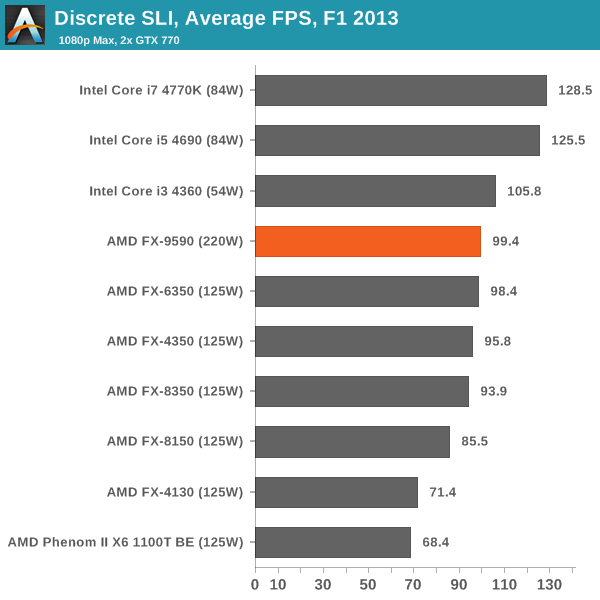
The FX-9590 seems to match the i3-4360, indicating that even more cores, more frequency and more PCIe lanes is not always a good thing. The i3-4360 is using PCIe 3.0 x8/x8, compared to PCIe 2.0 x16/x16 for the FX-9590, which should put them both equal in bandwidth.
Bioshock Infinite
Bioshock Infinite was Zero Punctuation’s Game of the Year for 2013, uses the Unreal Engine 3, and is designed to scale with both cores and graphical prowess. We test the benchmark using the Adrenaline benchmark tool and the Xtreme (1920x1080, Maximum) performance setting, noting down the average frame rates and the minimum frame rates.
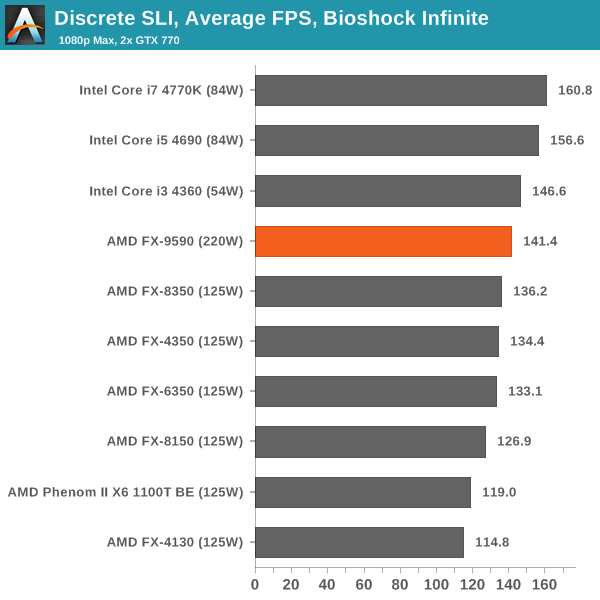
Again, the FX-9590 is trading around the Haswell i3 margin.
Tomb Raider
The next benchmark in our test is Tomb Raider. Tomb Raider is an AMD optimized game, lauded for its use of TressFX creating dynamic hair to increase the immersion in game. Tomb Raider uses a modified version of the Crystal Engine, and enjoys raw horsepower. We test the benchmark using the Adrenaline benchmark tool and the Xtreme (1920x1080, Maximum) performance setting, noting down the average frame rates and the minimum frame rates.
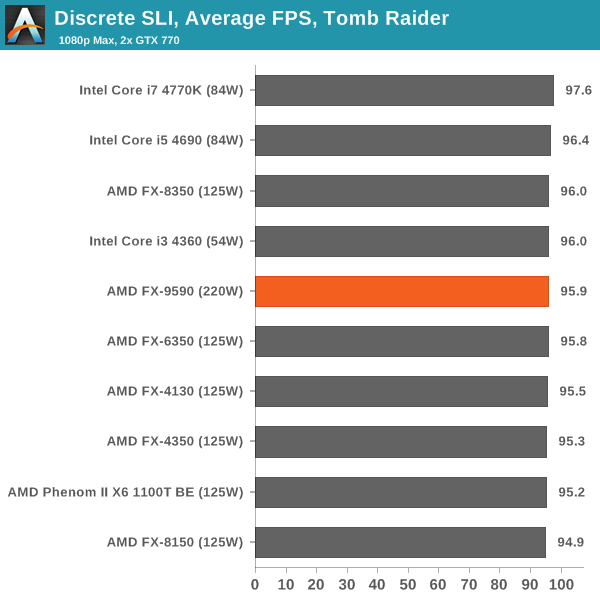
Tomb Raider has historically been CPU agnostic, with all the latest CPUs performing similarly.
Sleeping Dogs
Sleeping Dogs is a benchmarking wet dream – a highly complex benchmark that can bring the toughest setup and high resolutions down into single figures. Having an extreme SSAO setting can do that, but at the right settings Sleeping Dogs is highly playable and enjoyable. We run the basic benchmark program laid out in the Adrenaline benchmark tool, and the Xtreme (1920x1080, Maximum) performance setting, noting down the average frame rates and the minimum frame rates.
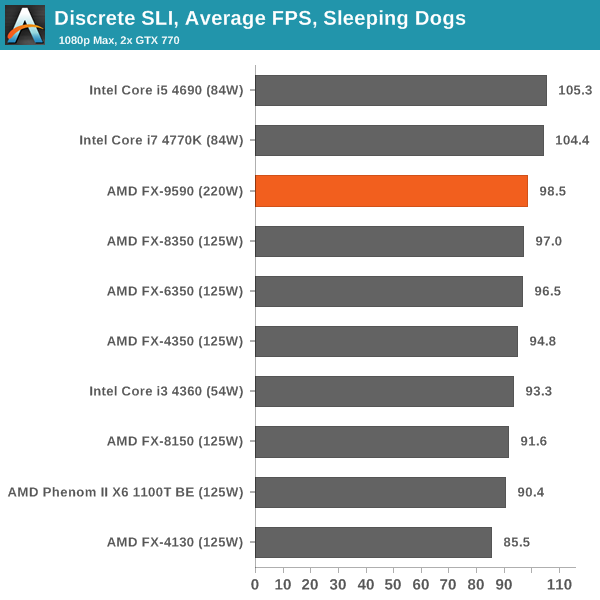
The FX-9590 loses 4-6 FPS on average to the latest Intel cohort, which is not bad considering the release date difference.
Company of Heroes 2
Company of Heroes 2 also can bring a top end GPU to its knees, even at very basic benchmark settings. To get an average 30 FPS using a normal GPU is a challenge, let alone a minimum frame rate of 30 FPS. For this benchmark I use modified versions of Ryan’s batch files at 1920x1080 on High. COH2 is a little odd in that it does not scale with more GPUs with the drivers we use.
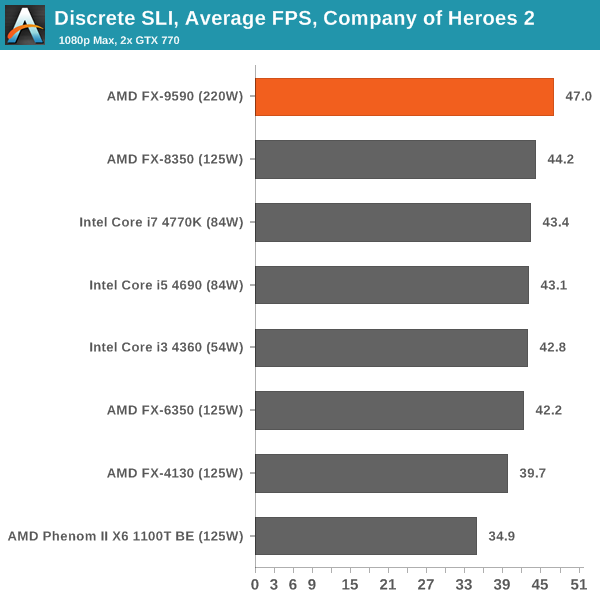
Company of Heroes 2 is usually relatively CPU agnostic except for the older dual core CPUs, but the FX-9590 gets a win here.
Battlefield 4
The EA/DICE series that has taken countless hours of my life away is back for another iteration, using the Frostbite 3 engine. AMD is also piling its resources into BF4 with the new Mantle API for developers, designed to cut the time required for the CPU to dispatch commands to the graphical sub-system. For our test we use the in-game benchmarking tools and record the frame time for the first ~70 seconds of the Tashgar single player mission, which is an on-rails generation of and rendering of objects and textures. We test at 1920x1080 at Ultra settings.
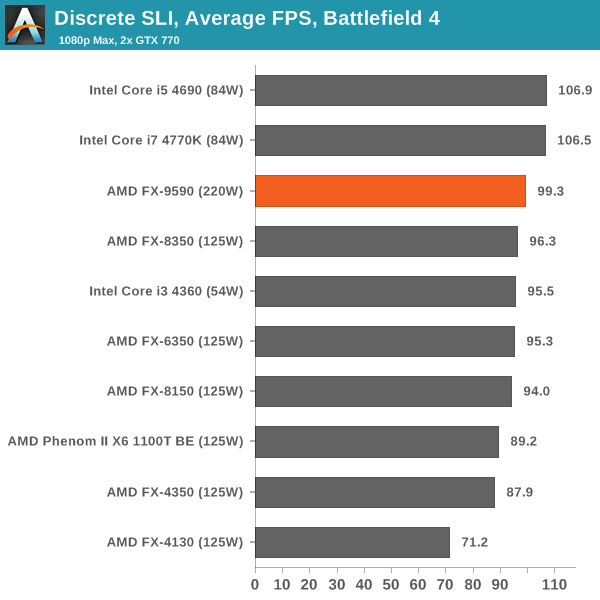
Similar to Sleeping Dogs, the FX-9590 does not lose much considering the release date difference of the architectures.






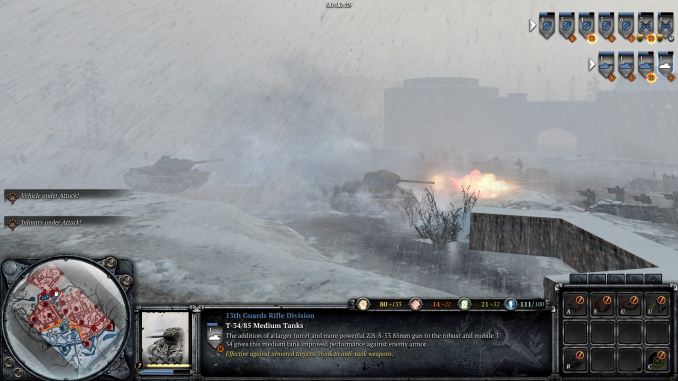









146 Comments
View All Comments
BMAN61 - Sunday, August 10, 2014 - link
" Alongside testing this CPU, the 220W TDP requires a substantial motherboard to match. Due to the age of the platform, the AM3+ socket and the old 990FX chipset, finding a motherboard can be rather tricky. Many of the AM3+ motherboards that were launched were only suited for the FX-8350 processors, which had a 125W TDP. This is yet another reason that AMD wanted the FX-9590 in the hands of system builders who would chose high end motherboards that could cope.Two of the newest motherboards to be released for 990FX were the ASRock 990FX Killer and the ASRock 990FX Extreme9. We reported the release of the Killer in December 2013, but the Killer is unsuitable here as the specification sheet lists processors up to 125W only. The Extreme9 is ASRock’s high-end AM3+ motherboard, and more suited to the task. "
This statement isn't entirely true; the ASUS Sabertooth 990FX motherboard supports this 220 watt CPU http://www.asus.com/ca-en/Motherboards/SABERTOOTH_... the only requirement is a BIOS update and better cooling.
StrangerGuy - Sunday, August 10, 2014 - link
So ~$170 solely for a mobo to reliably run a AMD chip.Intel is laughing to death somewhere a 4790K can be dropped into the cheapest of S1150 mobos and it just simply works.
just4U - Sunday, August 10, 2014 - link
Off the top of my head I don't know of anyone who has purchased a $350 i7 and paired it up with a $65 motherboard.. Most won't even use the stock cooler since +80c temperatures under load is a little on the alarming side.. Those that tend to purchase it as part of a new system are usually looking at $170 Motherboards and $30+ coolers.StrangerGuy - Sunday, August 10, 2014 - link
Intel temperature issues != AMD power delivery issues. The former can simply be solved with a $30 HSF, while the latter needs a $170 mobo AND even stronger cooling.And I'm one of those guys who run a 4790K on a $60 budget mobo. Paying an extra $100 for CPU at 4GHz stock with even higher turbo and HT is certainly more value for money than a $240 4690K with a $160 mobo with extravenous features that I don't need, and this does not include extra costs for cooling a OCed chip plus dealing with chip lottery. I don't know why is that even surprising to some...
just4U - Monday, August 11, 2014 - link
I don't believe you have a $60 board paired up with your 4790K. Sorry S... it simply doesn't make sense. You may not have Z97 deluxe but I think it's doubtful you've paired it with a H81 either.. That's like going out and buying a 780Ti and then using the worst turd of a PSU to power the damn thing.. or saying yeah this Celeron should be enough for that.. lol.. no.designgears - Sunday, August 10, 2014 - link
*facepalm*How many time did a stock i5 just beat an 8 core OC chip?!
mapesdhs - Tuesday, August 12, 2014 - link
A point which way too many AMD fans simply choose to ignore. Ah the 1st Rulestrikes again...
Ian.
nenforcer - Sunday, August 10, 2014 - link
The Realmark Audio Analyzer results have labeled this motherboard as having the Realtek ALC1150 audio codec just like most other modern motherboards, however, as stated previously in the article this motherboard has the older Realtek ALC898 codec.Jedibeeftrix - Sunday, August 10, 2014 - link
"If AMD is to return to the performance market, the power consumption has to be comparable to Intel, or if it is slightly higher, the chipset has to offer something Intel cannot. Any suggestions for what that feature should be should be submitted on a postcard/in the comments."24 PCIe 3.0 lanes on-die for uncompromised graphics whilst allowing M.2/Express at 3.0 4x:
http://jedibeeftrix.wordpress.com/2014/07/25/amd-t...
silverblue - Sunday, August 10, 2014 - link
Kaveri, from a technological standpoint, is a refined version of Zambezi, but it's still not perfect; they fixed an AVX bug but hamstrung FP adds somehow. Work done per module is improved due to the decoder changes.We don't know how L3 cache would help performance, as this is the first edition of the architecture that doesn't have such a flavour. The other issue is the reduced clock speed thanks to the 28nm SHP node; while it's very possible that a 4M/8T setup would exceed the 8350's performance, how much power would it use for that? I would theorise such a CPU (note - same clocks as the 7850K, and without L3 cache) outperforming the 8350 by about 10-15% in MT workloads, matching it in ST and even falling behind by 10-15% in FP; perhaps that's another reason for the lack of an FX line given that it'd be a regression. Right now, I don't think it'd serve in AMD's best interests to release a new FX series as it wouldn't benefit consumers at all.
I should imagine that if Excavator brings the rumoured IPC gains, AMD would simply dump AM3+ and resurrect FX as a 2M/4T FM2+ part; in essence, an i5 competitor. They did say that improved IPC was Excavator's raison d'etre; considering MT is fixed, it should mean instructions per core. Get the IPC high enough and they won't NEED to clock the parts so high, thus lower power; on this point, Carrizo is supposed to be rated at 65W TDP.